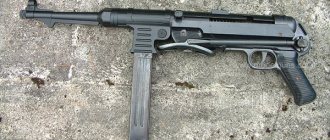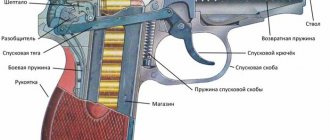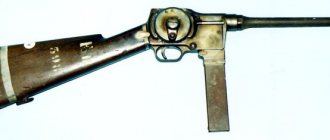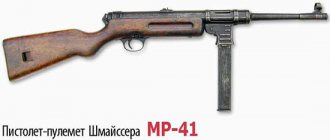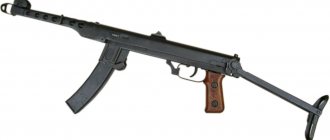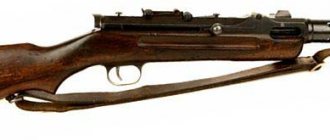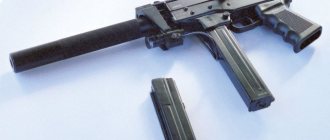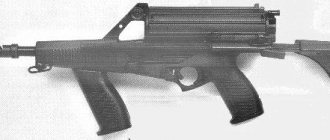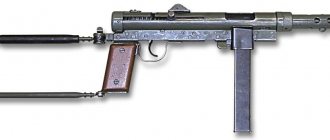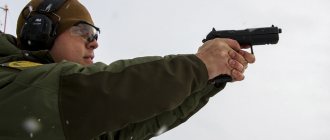Home | Weapons | Submachine guns | USA | Reising M50/M55
Reising M50/M55 submachine gun (USA)
Reising M50 submachine gun and Colt M1911A1 pistol
Reising M50 submachine gun
The Reising M50 submachine gun was designed and patented in 1940 by American designer Eugene Reising. Harrington & Richardson (H&R) began serial production of these weapons in 1941. In 1942, the US Marine Corps entered into a contract with H&R for their new submachine guns. During World War II, the M50 submachine gun was used by the US Navy, Coast Guard and Marine Corps. The M50 rating was supplied under Lend-Lease to Canada, the USSR, and other countries. Reising submachine guns were produced until 1945. After the end of the war, the Reising M60 self-loading carbine was developed and produced on its basis for the police and civilian arms market. A small-caliber version of this carbine was also produced under the designation M65, which used a 5.6 mm .22LR cartridge. Both had an extended barrel. The Reising M55 submachine gun differed from the Model 50 by the presence of a side-folding metal stock and the absence of a muzzle brake. The main purpose of the Reising M55 was to arm paratroopers and crews of combat vehicles. The Reising M55, in addition to its main drawbacks, had another one - weak fixation of the buttstock in the unfolded position, which is why this weapon did not enjoy a good reputation among paratroopers.
The Reising M50 submachine gun operates on the basis of automation using a semi-blowback. Shooting is carried out from a closed bolt. In the extreme forward position, the bolt protrusion enters with its protrusion, located in its upper rear part, into the groove of the receiver and warps upward. During a shot, the bolt begins to move back under the influence of the pressure of the powder gases at the bottom of the cartridge case. Slowing down its withdrawal is carried out by friction between the protrusion and the surface of the groove of the receiver. When the rear of the bolt exits the groove, the bolt moves freely to its rearmost position, removing the spent cartridge using the ejector and deflector. After which, under the influence of the spring, the bolt sends the next cartridge from the magazine into the chamber and again locks the barrel.
Navajo code talkers recruited and trained by the USMC who served in the Pacific theater during World War II were armed with Reising M50 submachine guns in addition to other small arms.
Reising M55 submachine gun
The bolt cocking handle is located at the bottom of the submachine gun fore-end, in front of the magazine receiver. When firing, this handle, which is not rigidly connected to the bolt, remains motionless. The trigger mechanism of the Reising M50 submachine gun is hammer-type, allowing firing in single shots and in bursts. The safety switch is made in the form of a slider and is located on the right side of the receiver. It has the following positions: extreme forward “FA” - fire in bursts; medium "SA" - single shooting; extreme rear "SAFE" - fuse. The Reising M50 has a muzzle compensator that reduces the weapon's toss when firing. The weapon is fed with cartridges from box magazines with a capacity of 20 or 12 rounds. Each submachine gun was supplied with six magazines. The sights on the Reising M50 submachine gun consist of a front sight and an adjustable aperture rear sight, allowing for accurate fire at distances of 50, 100, 200 and 300 yards.
For cleaning and inspection, the Reising submachine gun is disassembled in the following order: separate the magazine by pulling the latch back; separate the stock by unscrewing the connecting screw on the underside of the forend with a screwdriver; unscrew the butt plate from the receiver; pull back the bolt frame so that the transverse hole at the front end of the recoil spring guide rod becomes visible, and insert the end of the mainspring into this hole; separate the magazine receiver from the receiver by pushing out the two wedge-shaped pins holding it with a punch; separate the bolt frame with the return spring and its guide rod from the receiver; remove the trigger and bolt, for which, holding the weapon up with the barrel above the soft mat, press the trigger, after which these parts will fall down themselves. The instructions strongly discouraged disassembling the weapon too often, as this accelerated the wear of its parts, as well as using excessive force during disassembly and confusing parts of different weapons with each other, since they were not interchangeable.
Reising M55 submachine gun
Reising M55 with stock folded
Photo by Armament Services International, Inc.
The adoption of the Reising M50 submachine gun was a consequence of the high cost and complexity of producing Thompson submachine guns. The Reising M50 was more technologically advanced to manufacture and cost $50 apiece, while the Thompson submachine gun cost $225. In addition, the Reising M50 was much lighter and more maneuverable than the Thompson. In order to find a more technologically advanced submachine gun that was simpler in design and manufacture, a competition was organized in the USA, in which the Reising M50 demonstrated a number of advantages and was declared the winner. The Reising's high shooting accuracy was due to the fact that it fired from a closed bolt, while most submachine guns of that time did not use a hammer trigger and fired from an open bolt. In systems where shooting is carried out from an open bolt, in comparison with those firing from a closed one, additional impulses arise when the bolt moves forward, which leads to some displacement of the weapon from the aiming line.
But the M50 submachine gun also had its drawbacks, which in particular included low firepower due to the use of magazines with a capacity of only 20 rounds. The Thompson M1 and M1A1 used not only compact 20-round magazines, but also larger ones with a capacity of 30 rounds, not to mention the M1928 and M1928A1, which could be used with 50- and 100-round magazines. The small capacity of the M50 magazine limited the ability to conduct effective automatic fire, which was necessary in close combat, especially during clashes in urban environments. It is worth noting that this weapon was originally developed for the police; it was intended to be used primarily as a light self-loading carbine with the ability to fire in bursts. The Reising M50 submachine gun was used in the Pacific Theater during the war.
USMC training with Reising M55 submachine guns
The Reising M50 saw action in the Solomon Islands and the Battle of Guadalcanal. However, these weapons were used mostly by command personnel. In the US Marine Corps, the M50 submachine gun, in terms of its role of use, was somewhat of an analogue to the M1 carbine in the army. The reliability of the Reising submachine guns, created as police-civilian weapons, in harsh operating conditions in military operations on the islands of the Pacific Ocean with their characteristic sand and salt water, turned out to be extremely low. Delays in shooting often occurred due to rapid contamination of the receiver groove with powder soot and dirt. As a result, the bolt could not reach the extreme forward position, and the trigger continued to block the trigger, preventing a shot from being fired when the bolt was not completely closed. Parts from different copies of the M50 were not interchangeable due to individual adjustments during production, which significantly complicated the repair of weapons in the army.
During testing at the Aberdeen Proving Ground, an overly complicated procedure for assembling and disassembling weapons, as well as caring for them, was revealed. Reliability problems led the Marines to quickly get rid of these weapons. In particular, a significant case is when an entire battalion of Marines, on the orders of Lieutenant Colonel Merritt A. Edson, drowned their Reisings in the river in order to obtain a weapon more suitable for combat. The M50 was often replaced by self-loading 7.62 mm carbines, which earned a much better reputation among the troops. All this led to the Reising submachine guns being withdrawn from the troops at the end of 1943 and transferred to coast guard units, ship crews, as well as the police and State Defense Forces. In addition, the Reising M50 was supplied to the Office of Strategic Services (OSS), the first joint US intelligence service. A certain number of Reisings under the Lend-Lease program were sent to the allies, including the USSR, as well as to fighters of resistance movements in enemy-occupied territories.
TTX Reising M55
- Caliber: 11.43×23 (.45 ACP)
- Weapon length: 780/555 mm
- Barrel length: 265 mm
- Weight without cartridges: 2.8 kg.
- Rate of fire: 500-550 rds/min
- Magazine capacity: 20 rounds
Submachine guns
- Austria
- India
- Hungary
- Czech
- France
- USA
- Singapore
- Spain
- Croatia
- Chile
- Bulgaria
- Russia/USSR
- Australia
- Finland
- Germany
- Switzerland
- Denmark
- Egypt
- South Korea
- South Africa
- Japan
- Israel
- Sweden
- Belgium
- Poland
- Ukraine
- Italy
- Romania
- Yugoslavia
- Argentina
- China
- Portugal
- Great Britain
Reising M-50 and M-55 submachine gun (USA)
Early release Reising M50 submachine gun, so-called “commercial” or “police” model.
Late release ReisingM50 submachine gun, or “military” model.
ReisingM55 submachine gun with a folding stock in a stowed position.
Self-loading carbine Reising M60.
Characteristics
| Reising M50 | Reising M55 | |
| Caliber | .45 ACP | |
| Weight | 3.06 kg without cartridges | 2.81 kg without cartridges |
| Length (stock folded/opened) | 857 mm | 556 / 781 mm |
| Barrel length | 279 mm | 263 mm |
| Rate of fire | 550 rounds per minute | 500 rounds per minute |
| Store capacity | 12 or 20 rounds | 12 or 20 rounds |
| Effective range | 100 meters | 100 meters |
The Reising M50 submachine gun was developed and patented by American Eugene Reising in 1940. Production was established by Harrington & Richardson (H&R) in 1941, and in 1942, H&R received the first contract to supply new submachine guns to the US Marine Corps. The production of Reising submachine guns continued until 1945; after the war, they were used to produce the Reising M60 self-loading carbine, intended for civilian and police use. It should be noted that the Reising SMGs have not gained popularity among the Marines, mainly due to their high sensitivity to contamination, low reliability and significant complexity of the mechanisms. However, these same submachine guns were distinguished by good shooting accuracy, especially with single shots, and during the war years they were widely used to protect various military installations in the United States. In the post-war years, Reising SMGs were used by a number of police departments in the United States.
The Reising M50 submachine gun uses a semi-blowback action and fires from a closed bolt. Slowing down the opening of the bolt after a shot is carried out by inserting the protrusion in the rear upper part of the bolt into a groove in the receiver. The trigger mechanism is striker-fired and allows single and automatic fire; the fire mode selector is located on the right side of the receiver. The cocking handle is located in a groove in the lower part of the forend, in front of the magazine receiver. The Reising M50 submachine gun had a partially finned barrel and a muzzle brake-compensator. The Reising M50 submachine gun had a wooden stock with a semi-pistol grip. A variant of the Reising M55 submachine gun was issued for paratroopers and combat vehicle crews; it had a side-folding metal stock and a barrel without a compensator brake. The cartridges were fed from box magazines - double-row with a capacity of 20 rounds and single-row with a capacity of 12 rounds (the latter were intended for training aphids). Sights included a front sight and a diopter rear sight, adjustable in range from 50 to 300 yards.
Links[edit]
- ^ abcdefghijklmnopqrs Scarlata, Paul (13 January 2014). "Tommy Gun's Ugly Baby Step." Shotgun News. pp. 22–23.
- Dockery, Kevin (December 2004). Navy SEAL weapons
. New York: Berkeley Publishing Group. item 382. ISBN. 0-425-19834-0. - "Last submachine gun destined for mass production". Popular Science
(April): 73–77. 1941 - ^ abcdefghijklmnopqrstu Robert C. Anconi, "Reising's .45 Model 50 and 55 submachine gun and Model 60 semi-automatic rifle", Small Arms Review,
July 2008. - ^ ab Thomas B. Nelson, Submachine Guns of the World
, TBN Enterprises, 1963 - "Last submachine gun destined for mass production". Popular Science
. April 1941. pp. 73–76. ISSN 0161-7370. Retrieved June 13, 2011. - McCollum Ian (September 3, 2017). "Reising Model 60 - Wartime Semi-Automatic Carbine". YouTube
. Forgotten weapons. Retrieved June 20, 2022. - https://www.forgottenweapons.com/wp-content/uploads/manuals/Reising%2030%20carbine.pdf
- Jump up
↑ Harrington & Richardson Light Rifle. Forgotten weapons, archived April 12, 2011 at the Wayback Machine - Frank Iannamico, Reising the Submachine Gun History
, Moose Lake Publishing Co., statement by RG Rosenquist, Curator, US Raider Maritime Museum, on p.132. - https://www.rockislandauction.com/detail/56/1798/harrington-richardson-inc—mc58
- https://www.frfrogspad.com/leatherneck.htm
- ↑
S. Schmidt,
Manual for the Reising Submachine Gun: Caliber .45 Models 50, 55, and 60,
Government Printing Office, Washington, DC (1942): p.2. - ^ abc Lt. Col. John George, Shots in Anger
, Samworth Press, 1948 - Roy F. Dunlap, Gunnery Moved Forward
, Samworth Press, 1948 - p.14 Rottman Gordon and Chappell, Mike US Marine Corps 1941–1945
1995 Osprey Publishing - Frank Iannamico, Reising the Submachine Gun History
, Moose Lake Publishing, 1999. Pages 136-7 show tables of equipment, 1st Raider Battalion 24 Sep 42 and 1st Parachute Battalion 1 Jul 42. - ^ ab Frank Iannamico, The Reising Submachine Gun Story
, Moose Lake Publishing, 1999. - Army News, Benefits, Careers, Entertainment, Photos, Promotions - Army Times HOME
- Frank Iannamico, Reising the Submachine Gun History
, Moose Lake Publishing, 1999. Pages 130-135 cover commentary on Racing and Thompson by USMC vets. - p.515 Rottman, Gordon L. US Marine Corps World War II Order of Battle
2003 Greenwood Publishing - https://www.thememoryproject.com/digital-archive/profile.cfm?cnf=cf&collectionid=763 [ permanent dead link
] - "The Day Chicago Came to Oakland". NZ Herald. December 6, 2013. Retrieved May 14, 2022.
Modifications
There were two main modifications of the Reising submachine gun - M50
with a solid wooden stock (part of the release also had a front vertical fire control handle) and intended for paratroopers and crews of
M55
with a folding shoulder rest. The latter was also distinguished by the absence of a muzzle compensator and some simplification of the design.
More rare were self-loading carbines that did not have an automatic fire mode - M60
chambered for .45 ACP and a training version of
the M65
chambered for .22 LR. Both had an extended barrel.
A prototype of a similar design to the “Raising” PP, but chambered for the .30 Carbine cartridge, was exhibited at a competition to develop a light army carbine, but it was not it that was adopted for service, but a variant from Winchester, the M1 Carbine.
Model Confusion
What constitutes a “commercial” and a “military” Model 50 is amorphous. First, H&R never discriminated; the distinction is made by collectors. This confusion stems from the production period when the first '50s models were produced to commercial specifications, and H&R's wartime practice of randomly stocking old parts throughout production.[4]
Although there is no single factor that distinguishes a so-called commercial model from a military model, a commercial model is usually blued. It usually has a fixed front and rear sight with a non-locking screw. It often has 28 ribs on the barrel, a solid magazine release, no raised flanges on the safety/selector switch, and no swivels. Finally, the commercial model typically has a smooth removable screw, a two-hole trigger guard, and serial numbers ranging from one to 20,000.[4]
Military raids are usually parked. They often have an adjustable front sight with an Allen screw and a rear sight with a locking screw. They typically have 14 ribs on the barrel, a two-piece magazine release, external flanges on the safety/selector switch, sling swivels, stock ties (cross bolts through the handguard), and a removable thumbscrew. Finally, the military model typically has a three-hole trigger guard, telltale o or "Pm2" above the chamber, and serial numbers ranging from 20,000 to 120,000.[4]
There are three types of H&R magazines. The first and second models are smooth-bodied, blued, and feature a double-column design with a twenty-round barrel. The first model features five cartridge inspection holes on the left side, while the second model eliminates this feature to prevent dirt and sand from entering. In contrast, the third model is parked, has two long notches on the sides to reduce its capacity to a twelve-shot single-column magazine due to the feeding problems that previous models had.[4]
Users[edit]
- Argentina [1]
- Australia [1]
- Brazil [1]
- Canada [1]
- Costa Rica [1]
- French Indochina: 4000 ordered, delivery and issue not confirmed. [1]
- Finland: Captured by the Red Army. [1]
- Malaya: Received from the Malaysian Communist Party Militia. [1]
- Mexico [1]
- Nazi Germany: Captured by the Red Army. [1]
- New Zealand [1]
- Soviet Union: Received in the form of Lend-Lease assistance. [1]
- Philippines: Used by the Philippine Army and Philippine Constabulary during World War II and into the 1960s.
- USA [1]
- United Kingdom [1]
- Uruguay Uruguayan Navy [1]
- Venezuela [1]
- Iran [1]
Reliability issues
H&R was rightly proud of the Reising's superior precision and balance, lighter weight and ease of manufacture compared to the Thompson. However, Reising's tough tolerance and delicate magazine proved unreliable in the sand and dirt of the Solomon Islands - unless they were kept impeccably clean. The gun quickly became despised by frontline Marines, and Lt. Col. Merritt A. Edson, Commander, 1st Marine Raider Battalion, ordered Reising to be thrown into Guadalcanal's crocodile-infested Lunga River as his troops resorted to the trusty bolt-action Springfield rifles.[4]
This failure made a mockery of the slogan [4]
There are other reasons for his refusal. First of all, Reising is a complex design of many small pins, pistons, springs and levers. Disassembly and reassembly were difficult even under normal conditions. Simple maintenance was problematic because there was no bolt locking device. Inserting a cartridge into the cartridge was awkward, as the bolt bar was difficult to grip in the forearm, and the loop could get in the way. Worse, the safety switch/selector could not be felt at night if it was in the safe, semi or automatic position.[4]
"Fitting" of some parts during the manufacturing process limits interchangeability. The exposed rear sight had no protective ears and was vulnerable to breakage. The adjustable front sight could be lost if the mounting screw was not securely fastened. The weapon was susceptible to jamming if dirt clogged the bolt locking recess in the receiver. The two small magazine guide locking pins and corresponding receiver pin holes were tapered, allowing disassembly and reassembly in only one direction—right to left for disassembly and left to right for assembly; adding an unacceptable level of complexity to a combat environment. The locking pins had to be carefully knocked out whenever the bolt needed to be removed for cleaning; again, an awkwardly confusing task under fire. And then, when the pins had to be put back in during the assembly process, if they were pushed in too far or not far enough, the receiver might not fit back into the tight confines of the stock.[4]
Reising M50/M55
US Coast Guard employee with "Reising"
The main reason for the adoption of "Reising" was the problems that arose in the process of establishing mass production of insufficiently technologically advanced Thompsons. To find a cheaper and easier to produce replacement, a competition was organized, in which the Rising system showed superiority over its competitors and was declared the winner.
The "Raising" was a light and fairly accurate weapon, especially when firing a single shot, which it owed to the use in its design of a semi-free bolt and a relatively complex trigger mechanism that ensured firing from a closed bolt - unlike most submachine guns of those years, including the Thompson, in which the shot was fired from an open bolt, that is, at the moment the trigger was pressed, the bolt was in the extreme rear position and, starting to move forward, knocked down the sight immediately before the shot. At the same time, the Raising was inferior in firepower to other models of submachine guns due to the small magazine capacity, which limited the possibility of conducting effective automatic fire, which was the basis for the above assessment of it as a weapon, in its qualities closest to a light self-loading carbine , from which firing in bursts is possible only in exceptional cases.
In 1940, the "Raising" was adopted by the US Marine Corps, and it was planned to have 4,200 PP per division.
During World War II, this PP was used in the Pacific Theater of Operations, in particular in the battles in the Solomon Islands and the Battle of Guadalcanal. It was primarily used by command personnel, essentially acting in the Marine Corps as an analogue of the M1 carbine used by the US Army.
Also in some quantities, the "Raising" M55 with a folding stock entered service with paratrooper Marines (Paramarines) and armored vehicle crews, but enjoyed a bad reputation among them, mainly due to the unsuccessful design of the shoulder rest, which sometimes self-folded when firing.
Initially developed as a police weapon, designed for relatively “civilian” operating conditions, the “Raising”, as it soon became clear, was rather unsuitable for military operations in the conditions of the Pacific coast with its characteristic sand and salt water. The reliability of weapons in such conditions turned out to be extremely low. Testing at Aberdeen Proving Ground subsequently revealed that the weapon's assembly and disassembly was unnecessarily complex, so that maintenance of the weapon was also difficult. In addition, the parts of various weapons were not interchangeable due to individual adjustment during manufacture, which became a big problem during operation and repair in the army. The Soviet operating instructions, for example, categorically forbade mixing up parts of one submachine gun with parts of another during disassembly.
The design of the weapon was quite complex and, moreover, prone to delays when firing due to the rapid contamination of the receiver ledge, which serves to slow down the bolt's release, with dust and gunpowder fumes. In this case, the bolt did not reach the extreme forward position, and the trigger mechanism continued to block the trigger, preventing the shot from being fired. Such delays during firing were all the more difficult to eliminate given the fact that the Reising’s cocking handle was not rigidly connected to the bolt, which made it impossible to push it forward manually[1].
Ultimately, the Reising's reputation among the troops was extremely low, and many Marines tried to get rid of this weapon as quickly as possible. There is even a known case when an entire battalion of Marines, on the orders of Lieutenant Colonel Merritt A. Edson, sank their Raisings in the river in order to obtain a weapon more suitable for combat [2]. Often this was the M1 self-loading carbine.
As a result, at the end of 1943, the Raisings were withdrawn from the troops and transferred to coast guard units and ship commands, as well as the police, State Defense Forces and OSS. Some of these weapons, which showed their unsuitability for combat operations, were sent to the allies under Lend-Lease, including the USSR, as well as to various resistance movements. In Canada, “Raisings” were received by volunteers guarding German prisoners of war and reserve units, along with other obsolete weapon models.
Designated as a New SMG in Medal of Honor: Pacific Assault
